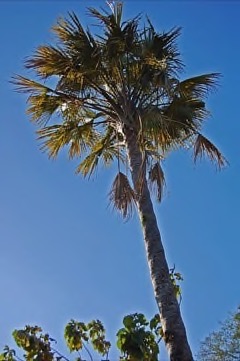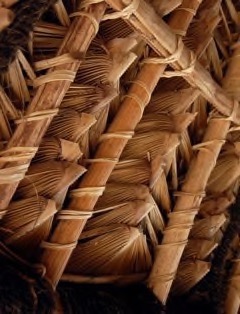 |
|
wikimedia.org W.A. Djatmiko (Wie146) |
 |
| wikimedia.org W.A. Djatmiko (Wie146) |
Translate this page:
Summary
Physical Characteristics

 Corypha utan is an evergreen Tree growing to 18 m (59ft) by 4 m (13ft) at a slow rate.
Corypha utan is an evergreen Tree growing to 18 m (59ft) by 4 m (13ft) at a slow rate.
See above for USDA hardiness. It is hardy to UK zone 10.
Suitable for: light (sandy), medium (loamy) and heavy (clay) soils. Suitable pH: mildly acid, neutral and basic (mildly alkaline) soils. It cannot grow in the shade. It prefers dry or moist soil.
UK Hardiness Map
US Hardiness Map
Synonyms
Borassus sylvestris Giseke Corypha elata Roxb. Corypha gebang Mart. Corypha gembanga (Blume) Blume Corypha griffithiana Becc. Corypha macrophylla Roster Corypha macropoda Kurz ex Linden Corypha macropoda Linden ex Kurz Corypha sylvestris Mart. Gembanga rotundifolia Blume Livistona vidalii Becc. Taliera elata (Roxb.) Wall. Taliera gembanga Blume Taliera sylvestris Blume
Plant Habitats
Edible Uses
Edible Parts: Apical bud Flowers Seed Stem
Edible Uses: Drink Sweetener
A sweet sap is obtained from the inflorescence[297 ]. This can be used as sugar or fermented into an alcoholic drink[297 ]. Apical bud - raw, cooked with rice or pickled[301 ]. Eaten raw as a salad, or cooked as a vegetable[46 , 360 ]. Eating this bud effectively kills the plant because it is unable to make side branches[301 , K ]. A starch obtained from the pith of the stem is used to make sago[46 , 301 , 360 ]. The kernels of young seeds are eaten or made into sweetmeats[46 , 301 , 360 ].
References More on Edible Uses
Medicinal Uses
Plants For A Future can not take any responsibility for any adverse effects from the use of plants. Always seek advice from a professional before using a plant medicinally.
Antidiarrhoeal Antitussive Demulcent Diuretic Emollient Febrifuge Stimulant
The roots are demulcent, diuretic, emollient and stimulant[360 ]. The roots are chewed in the treatment of coughs[360 ]. The juice of the roots is used for treating diarrhea360]. A decoction of the young plant is used in the treatment of febrile catarrh[360 ] . The starch from the trunk is used in the treatment of bowel complaints[360 ].
References More on Medicinal Uses
The Bookshop: Edible Plant Books
Our Latest books on Perennial Plants For Food Forests and Permaculture Gardens in paperback or digital formats.

Edible Tropical Plants
Food Forest Plants for Hotter Conditions: 250+ Plants For Tropical Food Forests & Permaculture Gardens.
More

Edible Temperate Plants
Plants for Your Food Forest: 500 Plants for Temperate Food Forests & Permaculture Gardens.
More

More Books
PFAF have eight books available in paperback and digital formats. Browse the shop for more information.
Shop Now
Other Uses
Basketry Beads Broom Buttons Fibre String Thatching
The leaves have a wide range of uses, including thatching for roofs and walls, weaving into baskets, mats, hats etc[297 , 454 ]. The ribs of the leaves is used for making brooms[360 ]. A fibre, known as 'buntal', is obtained from the leaf petioles[46 , 360 ]. It is used for making Lucban and Baliuag hats, and for making rope[46 , 360 ]. A very fine fibre is obtained from the unfolded leaves[46 , 360 ]. Used for cloth, fancy articles and as a string[46 ]. Fibres from the ribs of unfolded leaves are used for making Calasiao hats[46 ]. The mature seeds are made into buttons or used as beads on rosaries[46 , 360 ].
Special Uses
Carbon Farming Food Forest
References More on Other Uses
Cultivation details
Industrial Crop: Fiber Management: Standard Regional Crop Staple Crop: Sugar
Plants succeed in moist tropical climates where temperatures never fall below 10°c, the average annual rainfall is 1,500mm or more and the driest month has 25mm or more rain[297 ]. They can also succeed in drier areas with an annual rainfall as low as 250mm and one month or more where rainfall is below 25mm[297 ]. Plants grow well in full sun, even when small[297 ]. Plants are monocarpic - living for many years without flowering, but then dying after they flower[200 ]. Like all members of this genus, these palms only flower at the end of their life, sending up a massive inflorescence, up to 5 metres high, and with up to 1 million flowers[314 ]. Plants are slow-growing when young[200 ].
Carbon Farming
-
Industrial Crop: Fiber
Clothing, rugs, sheets, blankets etc. Currently, almost none of our fiber are produced from perennial crops but could be!
-
Management: Standard
Plants grow to their standard height. Harvest fruit, seeds, or other products. Non-Destructive management systems.
-
Regional Crop
These crops have been domesticated and cultivated regionally but have not been adopted elsewhere and are typically not traded globally, Examples in this broad category include perennial cottons and many nuts and staple fruits.
-
Staple Crop: Sugar
Perennial sugar crops include sugarcane and compare favorably to annuals.
References Carbon Farming Information and Carbon Sequestration Information
Temperature Converter
Type a value in the Celsius field to convert the value to Fahrenheit:
Fahrenheit:
The PFAF Bookshop
Plants For A Future have a number of books available in paperback and digital form. Book titles include Edible Plants, Edible Perennials, Edible Trees,Edible Shrubs, Woodland Gardening, and Temperate Food Forest Plants. Our new book is Food Forest Plants For Hotter Conditions (Tropical and Sub-Tropical).
Shop Now
Plant Propagation
Seed.
Other Names
If available other names are mentioned here
Bajur, Bajurgatul, Buoon cao, Buri palm, Gebang palm, Gewang, Ibus, Komolu Silag, Lan phru, Las, Lontar utan, Pe-bin, Pochok, Puchuk, Tali
Native Range
TROPICAL ASIA: India, Papua New Guinea, Myanmar, Indonesia, Malaysia, Philippines AUSTRALASIA: Australia (Queensland, Northern Territory)
Weed Potential
Right plant wrong place. We are currently updating this section.
Please note that a plant may be invasive in one area but may not in your area so it's worth checking.
None Known
Conservation Status
IUCN Red List of Threatened Plants Status : Status: Least Concern

Growth: S = slow M = medium F = fast. Soil: L = light (sandy) M = medium H = heavy (clay). pH: A = acid N = neutral B = basic (alkaline). Shade: F = full shade S = semi-shade N = no shade. Moisture: D = dry M = Moist We = wet Wa = water.
Now available:
Food Forest Plants for Mediterranean Conditions
350+ Perennial Plants For Mediterranean and Drier Food Forests and Permaculture Gardens.
[Paperback and eBook]
This is the third in Plants For A Future's series of plant guides for food forests tailored to
specific climate zones. Following volumes on temperate and tropical ecosystems, this book focuses
on species suited to Mediterranean conditions—regions with hot, dry summers and cool, wet winters,
often facing the added challenge of climate change.
Read More
Expert comment
Author
Lam.
Botanical References
Links / References
For a list of references used on this page please go here
A special thanks to Ken Fern for some of the information used on this page.
Readers comment
| Add a comment |
|
If you have important information about this plant that may help other users please add a comment or link below. Only comments or links that are felt to be directly relevant to a plant will be included. If you think a comment/link or information contained on this page is inaccurate or misleading we would welcome your feedback at [email protected]. If you have questions about a plant please use the Forum on this website as we do not have the resources to answer questions ourselves.
* Please note: the comments by website users are not necessarily those held by PFAF and may give misleading or inaccurate information.
To leave a comment please Register or login here All comments need to be approved so will not appear immediately.
|
|